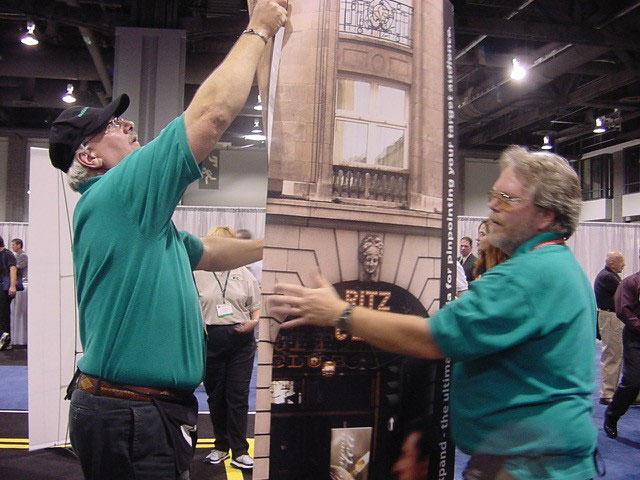
On May 21, 2024, Jim Wurm from the Exhibitor Appointed Contractor Association (EACA) presented a webinar on the State of the Labor Industry particularly as it relates to the production of trade shows and events. Jim was joined by Bill Muller from Nth Degree. The webinar was hosted by EDPA Northwest.
To watch the webinar on YouTube, click HERE. Below are 10 Questions and Answers about Trade Show Labor in 2024.
#1. Why does our industry need/require unions?
The trade show and event industry relies on a standby workforce that’s needed to move events in and out of our convention venues. Labor unions provide a ready source to fulfill that need.
#2. Who decides which unions work in which venues?
Labor jurisdictions are determined by the owner of the venue in question. The great majority of our convention venues are owned by the state or the city in its respective locale. And, while there are right-to-work states where a worker doesn’t have to be a union member to perform the described work, there are even venues in right-to-work states that have established union jurisdictions (e.g. McCormick Place). A complete list of union jurisdictions can be found on the EACA website..
#3. How do show rates get established?
Show rates are established by the General Service Contractor after approval by show management. EAC labor contractors can adopt the “show rate” for their own pricing but most establish their own labor rates city by city.
#4. What’s the difference between GC and EAC labor?

GCs have many sources of revenue from the variety of services they provide. The GC views show management as their primary client, and as such, the most experienced and skilled labor is assigned to work on show management jobs. The labor provided by the GC for display I&D is primarily assigned on a “next man up” basis. As a result, the labor provided to an exhibitor to set up their booth may have never seen the exhibitor display previously and may or may not have the necessary tools for the job. And the crew the exhibitor is provided on the installation can be completely different on the dismantle.
EAC labor is different. Since EACs only have one source of revenue, their labor solution is provided to tailor the service option to the exhibitor client needs. Exhibit design is often reviewed prior to the show so that the EAC can provide a crew that is appropriate for the work required. The EAC will also generally provide a specific “lead” to have supervisory responsibility for the job. This is done to make sure the rest of the crew is working efficiently and effectively.
With larger or more complicated jobs, the EACs may be requested to not only review display design but also to issue a “not to exceed” estimate for set-up and tear down. And as a matter of common practice, EAC labor contractors routinely make sure that the same crew that installs the display takes it down and repacks it.
#5. How does one join a union?
Any individual of age 18 with either a high school diploma or GED can join a union. An application is required along with an application fee. At many locals, a pre-employment drug test will be required.
#6. What’s the difference between a journeyman and apprentice?
Just as the terms imply, an apprentice is a union worker in training and a journeyman is an experienced union worker that has fulfilled all training requirements. Apprenticeship training includes 2000 hours of classroom and on the job work.
#7. What is a grievance?
Contractors that employ union workers negotiate and sign collective bargaining agreements with local unions. If the contractor breaches that agreement in some fashion, the local union can file a grievance that typically involves a monetary component to resolve.
#8. What do I do if I don’t like an individual on my crew?
Any exhibitor or display supervisor that has a concern or issue with a member of their crew can request a change from their contractor. Change requests should be made privately with the appropriate supervisor.
#9. What work can my shop supervisor do in a union venue?
Unless they are a member of the local union with jurisdiction, the only thing a supervisor can do during move-in and move-out is to provide direction, answer questions, and provide suggestions on the best and most efficient way to complete the work. The shop supervisor should first identify who is the “lead” in the job and communicate primarily with that individual to maximize efficiency.
#10. Why does my shop supervisor have to register as an EAC?

As a means of managing the risk of being responsible for everything that happens in a venue during their tenancy, show management requires that all who enter the construction zone during move-in and move-out, known as the show floor, provide a current copy of their company’s Certificate of Insurance (COI).
Understanding that there is risk of personal injury or possible damage to the venue or the exhibitor’s displays or products, show management doesn’t want to be held responsible for the negligent acts of others. Show management obtains COIs from their GC and all their exhibitors as a matter of course as they contract with them.
But they don’t know which EAC service providers are being hired by their individual exhibitors. That is the purpose of the EAC notification form.
The EAC Notification form pertains to any product or service provider that needs or wants to enter the show floor.
Some shop supervisors have presumed they could utilize their client’s or their labor company’s COI as adequate coverage for themselves. But just like you aren’t covered in an auto accident with someone else’s insurance, you’re not covered by your client or your labor company if you should be injured on the show floor. And show management doesn’t want to be liable as well.

Jim Wurm began his career in the trade show industry more than 35 years ago and has worked almost every job in a convention center from the loading dock to the main entry.
He has played a role in designing, building, shipping and setting up trade show booths as well as launching and organizing trade shows throughout the U.S. and Europe. Most recently, Jim has utilized his unique trade show experience for the development and management of the Exhibitor Appointed Contractor Association, better known as EACA.
Tags: Bill Muller, EACA, EDPA Northwest, Jim Wurm, trade show labor, Trade Shows



